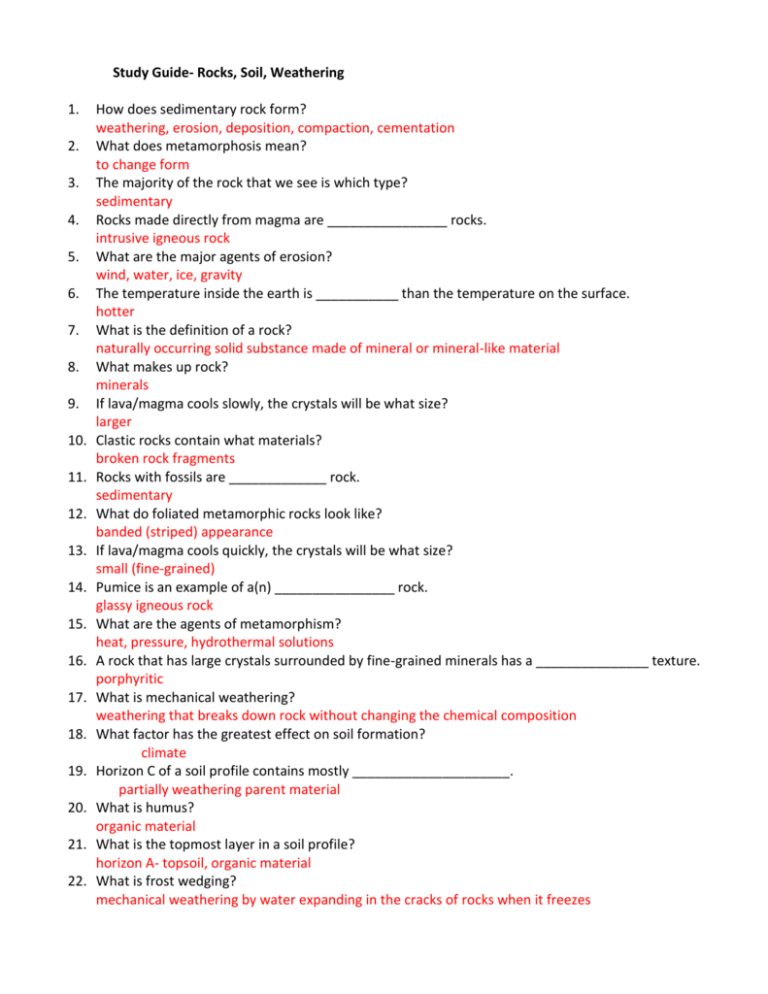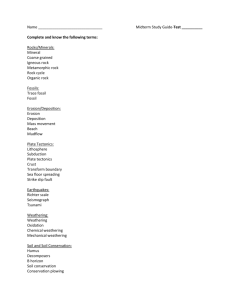Study Guide- Rocks, Soil, Weathering
advertisement

Study Guide- Rocks, Soil, Weathering 1. 2. 3. 4. 5. 6. 7. 8. 9. 10. 11. 12. 13. 14. 15. 16. 17. 18. 19. 20. 21. 22. How does sedimentary rock form? weathering, erosion, deposition, compaction, cementation What does metamorphosis mean? to change form The majority of the rock that we see is which type? sedimentary Rocks made directly from magma are ________________ rocks. intrusive igneous rock What are the major agents of erosion? wind, water, ice, gravity The temperature inside the earth is ___________ than the temperature on the surface. hotter What is the definition of a rock? naturally occurring solid substance made of mineral or mineral-like material What makes up rock? minerals If lava/magma cools slowly, the crystals will be what size? larger Clastic rocks contain what materials? broken rock fragments Rocks with fossils are _____________ rock. sedimentary What do foliated metamorphic rocks look like? banded (striped) appearance If lava/magma cools quickly, the crystals will be what size? small (fine-grained) Pumice is an example of a(n) ________________ rock. glassy igneous rock What are the agents of metamorphism? heat, pressure, hydrothermal solutions A rock that has large crystals surrounded by fine-grained minerals has a _______________ texture. porphyritic What is mechanical weathering? weathering that breaks down rock without changing the chemical composition What factor has the greatest effect on soil formation? climate Horizon C of a soil profile contains mostly _____________________. partially weathering parent material What is humus? organic material What is the topmost layer in a soil profile? horizon A- topsoil, organic material What is frost wedging? mechanical weathering by water expanding in the cracks of rocks when it freezes 23. What is the most important agent in chemical weathering? water 24. Is the current rate of soil erosion higher or lower than past rates of soil erosion? higher because of human impact 25. Where does the energy that powers the rock cycle come from? the sun and earth's interior heat 26. How does glassy-textured igneous rocks form? very quick cooling 27. What are the major components of soil? air, water, mineral matter, organic matter 28. In which type of climate is chemical weathering most effective? warm, humid 29. What is the force behind mass movements? gravity 30. What is the difference between mechanical weathering and chemical weathering? chemical changes the chemical composition and mechanical does not 31. Classify the following as either mechanical or chemical weathering: a. Frost wedging- mechanical b. Acid rain- chemical c. Reactions with water- chemical d. Reactions with oxygen- chemical e. Biological activity- mechanical f. Abrasion- mechanical g. Exfoliation and unloading- mechanical 32. What happens to water as it freezes? How is this related to frost wedging? it expands (volume increases); when it freezes in the cracks of rocks, it breaks the rock apart, thus causing weathering 33. What are some factors that trigger mass movements? steep slope, water, shaking 34. What is the slowest type of mass movement? creep 35. How does deforestation contribute to mass movements? taking out trees removes root systems that bind soil together, so it loosens the soil, which increase slope instability 36. What is slump? when a block of land moves downhill 37. What are various ways to stabilize slopes? drainage pipes to reduce the weight of water, wire mesh sprayed with concrete, rock bolts, terracing, retaining walls 38. Know how to read a soil composition chart






